The Energy Dispersive X-ray Spectrometer Market is estimated to be valued at USD 1.2 billion in 2025 and is projected to reach USD 2.4 billion by 2035, registering a compound annual growth rate (CAGR) of 7.5% over the forecast period.
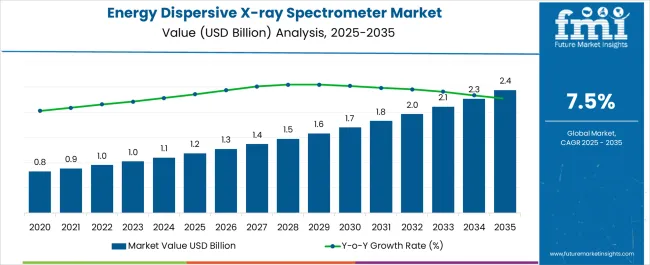
| Metric | Value |
|---|---|
| Energy Dispersive X-ray Spectrometer Market Estimated Value in (2025 E) | USD 1.2 billion |
| Energy Dispersive X-ray Spectrometer Market Forecast Value in (2035 F) | USD 2.4 billion |
| Forecast CAGR (2025 to 2035) | 7.5% |
The Energy Dispersive X-ray Spectrometer market is experiencing sustained growth driven by the rising demand for rapid, high-precision elemental analysis across multiple industries. The current market scenario is shaped by technological advancements that enhance detector sensitivity, resolution, and software-enabled analytics, allowing for faster and more accurate material characterization. Adoption has been accelerated by increased research and development activities, particularly in materials science, nanotechnology, and semiconductor sectors, where precise elemental mapping is critical.
Growth is also supported by the trend toward compact, user-friendly spectrometers suitable for laboratory and field use, offering both portability and integration with complementary analytical tools. The future outlook is expected to remain positive due to the ongoing need for quality control, regulatory compliance, and academic research.
Increasing investments in advanced manufacturing, energy materials, and analytical instrumentation, combined with rising awareness of the benefits of real-time analysis, are further strengthening market growth prospects As industries continue to prioritize efficiency, accuracy, and operational flexibility, the Energy Dispersive X-ray Spectrometer market is positioned for sustained expansion.
The energy dispersive x-ray spectrometer market is segmented by component, application, end-user, technology, mobility, and geographic regions. By component, energy dispersive x-ray spectrometer market is divided into Detector, X-Ray Source, Sample Holder, Control Electronics, and Software. In terms of application, energy dispersive x-ray spectrometer market is classified into Material Analysis, Environmental Testing, Oil And Gas Industry, Pharmaceuticals, and Mining And Metallurgy. Based on end-user, energy dispersive x-ray spectrometer market is segmented into Research Laboratories, Manufacturing And Quality Control, Academic Institutions, Government Agencies, and Environmental Organizations.
By technology, energy dispersive x-ray spectrometer market is segmented into Silicon Drift Detector (SDD), Proportional Counter, and Scintillation Detectors. By mobility, energy dispersive x-ray spectrometer market is segmented into Portable EDXRF Spectrometers and Benchtop EDXRF Spectrometers. Regionally, the energy dispersive x-ray spectrometer industry is classified into North America, Latin America, Western Europe, Eastern Europe, Balkan & Baltic Countries, Russia & Belarus, Central Asia, East Asia, South Asia & Pacific, and the Middle East & Africa.
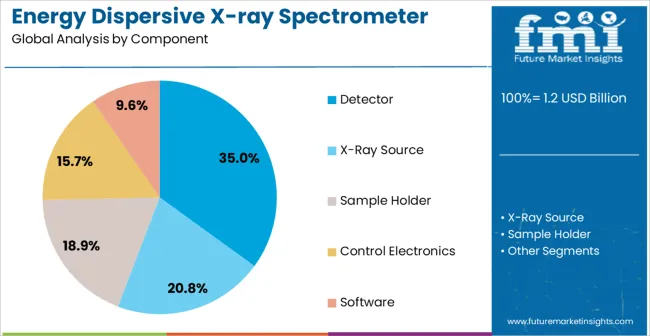
The Detector component segment is projected to hold 35.00% of the Energy Dispersive X-ray Spectrometer market revenue share in 2025, making it the leading component. This prominence has been driven by the critical role detectors play in achieving high-resolution spectral data and precise elemental identification. The segment has benefited from continuous improvements in detector technology, including enhanced sensitivity and energy resolution, which enable accurate quantification of trace elements.
Adoption has been fueled by the need for reliable, reproducible results in both research and industrial applications. The ability of modern detectors to integrate with advanced software for data processing and automated analysis has reinforced their importance.
Furthermore, the scalability of detector systems across various spectrometer models has reduced replacement costs and increased deployment flexibility The sustained growth of the detector segment is also supported by its centrality in delivering actionable insights across sectors, ensuring high demand from research laboratories and quality control operations that rely on rapid, precise measurements for critical decision-making.
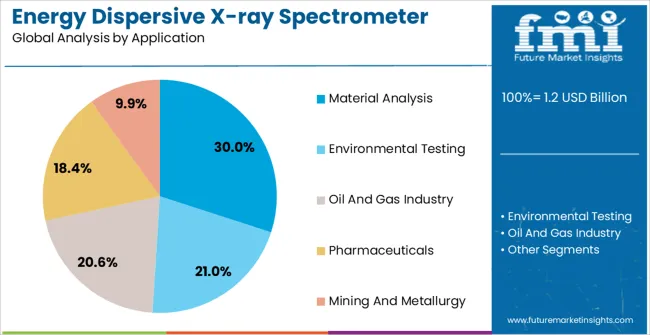
The Material Analysis application segment is expected to account for 30.00% of total Energy Dispersive X-ray Spectrometer market revenue in 2025, establishing it as the dominant application area. Growth has been driven by the increasing requirement for precise chemical composition and structural characterization across advanced manufacturing, metallurgical, and nanotechnology sectors. Material analysis relies heavily on the spectrometer’s capability to deliver fast and accurate detection of multiple elements simultaneously, which is critical for research and quality assurance processes.
The adoption of software-enabled data acquisition and automated analysis workflows has enhanced efficiency, accuracy, and reproducibility, thereby encouraging wider deployment. Material analysis is increasingly being incorporated into routine laboratory operations and research protocols, ensuring consistent demand.
Furthermore, rising investments in energy storage materials, semiconductors, and composite materials are contributing to the segment’s expansion As industries continue to pursue innovation and regulatory compliance, material analysis applications are expected to sustain their market leadership through reliable, actionable elemental data delivered by Energy Dispersive X-ray Spectrometer systems.
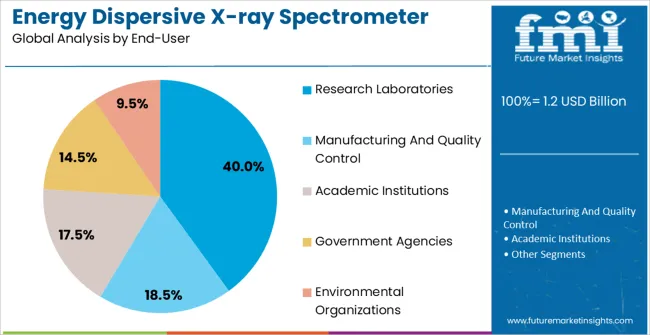
The Research Laboratories end-use industry segment is anticipated to hold 40.00% of the Energy Dispersive X-ray Spectrometer market revenue in 2025, emerging as the leading consumer. This dominance is being driven by the extensive use of spectrometers for experimental research, academic studies, and material characterization in laboratory environments. Research laboratories benefit from the flexibility and precision offered by modern Energy Dispersive X-ray Spectrometer systems, which allow for detailed elemental mapping and rapid analysis across a wide range of sample types.
Adoption has been reinforced by the increasing emphasis on high-throughput experimentation, reproducibility, and integration with other analytical techniques for comprehensive research outcomes. The segment has further grown due to expanding investments in scientific research and development, which create a constant demand for advanced instrumentation capable of supporting innovation.
Additionally, laboratories favor systems that allow software-based upgrades and compatibility with diverse detectors, maximizing return on investment and ensuring long-term operational efficiency The sustained need for accurate and efficient analytical solutions is expected to maintain the segment’s leadership in the market, as research activities across materials science, chemistry, and life sciences continue to expand globally.
Like several other quality control analysis instruments, Energy Dispersive X-ray Spectrometer market has gained a sizable momentum in the overall sales of the products over the period. Energy Dispersive X-ray Spectrometer is an important technique used in several research applications across the globe.
Energy Dispersive X-ray Spectrometer is used for detecting the x-rays generated by the collision between the object and incident electron beams using SEMs and TEMs. The global market for Energy Dispersive X-ray Spectrometer is likely to create substantial incremental opportunities for the key manufacturing companies of the Energy Dispersive X-ray Spectrometer to penetrate a significant market share in the emerging economies due to continuous growing healthcare infrastructure.
The global Energy Dispersive X-ray Spectrometer market is a house of several local and key manufacturing companies.
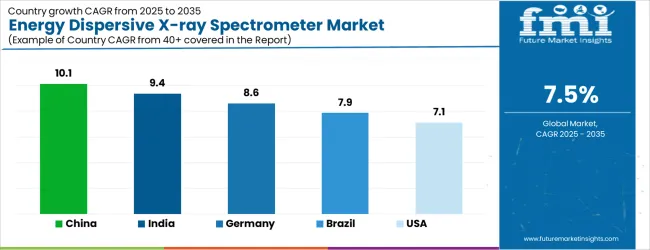
| Country | CAGR |
|---|---|
| China | 10.1% |
| India | 9.4% |
| Germany | 8.6% |
| Brazil | 7.9% |
| USA | 7.1% |
| UK | 6.4% |
| Japan | 5.6% |
The Energy Dispersive X-ray Spectrometer Market is expected to register a CAGR of 7.5% during the forecast period, exhibiting varied country level momentum. China leads with the highest CAGR of 10.1%, followed by India at 9.4%. Developed markets such as Germany, France, and the UK continue to expand steadily, while the USA is likely to grow at consistent rates. Japan posts the lowest CAGR at 5.6%, yet still underscores a broadly positive trajectory for the global Energy Dispersive X-ray Spectrometer Market. In 2024, Germany held a dominant revenue in the Western Europe market and is expected to grow with a CAGR of 8.6%. The USA Energy Dispersive X-ray Spectrometer Market is estimated to be valued at USD 409.1 million in 2025 and is anticipated to reach a valuation of USD 409.1 million by 2035. Sales are projected to rise at a CAGR of 0.0% over the forecast period between 2025 and 2035. While Japan and South Korea markets are estimated to be valued at USD 53.6 million and USD 39.8 million respectively in 2025.
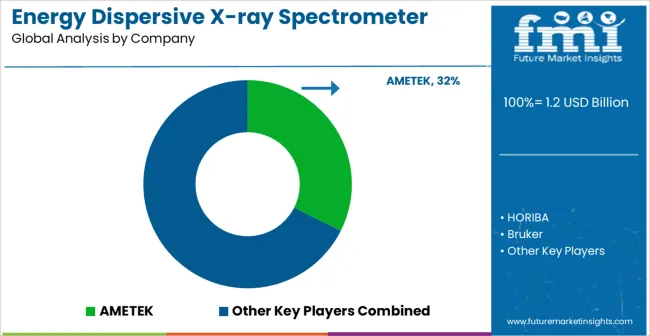
| Item | Value |
|---|---|
| Quantitative Units | USD 1.2 Billion |
| Component | Detector, X-Ray Source, Sample Holder, Control Electronics, and Software |
| Application | Material Analysis, Environmental Testing, Oil And Gas Industry, Pharmaceuticals, and Mining And Metallurgy |
| End-User | Research Laboratories, Manufacturing And Quality Control, Academic Institutions, Government Agencies, and Environmental Organizations |
| Technology | Silicon Drift Detector (SDD), Proportional Counter, and Scintillation Detectors |
| Mobility | Portable EDXRF Spectrometers and Benchtop EDXRF Spectrometers |
| Regions Covered | North America, Europe, Asia-Pacific, Latin America, Middle East & Africa |
| Country Covered | United States, Canada, Germany, France, United Kingdom, China, Japan, India, Brazil, South Africa |
| Key Companies Profiled | AMETEK, HORIBA, Bruker, Hitachi High-Tech, IXRF Systems, Olympus, SPECTRO, Cox Analytical Systems, and EVIDENT |
The global energy dispersive X-Ray spectrometer market is estimated to be valued at USD 1.2 billion in 2025.
The market size for the energy dispersive X-Ray spectrometer market is projected to reach USD 2.4 billion by 2035.
The energy dispersive X-Ray spectrometer market is expected to grow at a 7.5% CAGR between 2025 and 2035.
The key product types in energy dispersive X-Ray spectrometer market are detector, X-Ray source, sample holder, control electronics and software.
In terms of application, material analysis segment to command 30.0% share in the energy dispersive X-Ray spectrometer market in 2025.






Our Research Products

The "Full Research Suite" delivers actionable market intel, deep dives on markets or technologies, so clients act faster, cut risk, and unlock growth.

The Leaderboard benchmarks and ranks top vendors, classifying them as Established Leaders, Leading Challengers, or Disruptors & Challengers.

Locates where complements amplify value and substitutes erode it, forecasting net impact by horizon

We deliver granular, decision-grade intel: market sizing, 5-year forecasts, pricing, adoption, usage, revenue, and operational KPIs—plus competitor tracking, regulation, and value chains—across 60 countries broadly.

Spot the shifts before they hit your P&L. We track inflection points, adoption curves, pricing moves, and ecosystem plays to show where demand is heading, why it is changing, and what to do next across high-growth markets and disruptive tech

Real-time reads of user behavior. We track shifting priorities, perceptions of today’s and next-gen services, and provider experience, then pace how fast tech moves from trial to adoption, blending buyer, consumer, and channel inputs with social signals (#WhySwitch, #UX).

Partner with our analyst team to build a custom report designed around your business priorities. From analysing market trends to assessing competitors or crafting bespoke datasets, we tailor insights to your needs.
Supplier Intelligence
Discovery & Profiling
Capacity & Footprint
Performance & Risk
Compliance & Governance
Commercial Readiness
Who Supplies Whom
Scorecards & Shortlists
Playbooks & Docs
Category Intelligence
Definition & Scope
Demand & Use Cases
Cost Drivers
Market Structure
Supply Chain Map
Trade & Policy
Operating Norms
Deliverables
Buyer Intelligence
Account Basics
Spend & Scope
Procurement Model
Vendor Requirements
Terms & Policies
Entry Strategy
Pain Points & Triggers
Outputs
Pricing Analysis
Benchmarks
Trends
Should-Cost
Indexation
Landed Cost
Commercial Terms
Deliverables
Brand Analysis
Positioning & Value Prop
Share & Presence
Customer Evidence
Go-to-Market
Digital & Reputation
Compliance & Trust
KPIs & Gaps
Outputs
Full Research Suite comprises of:
Market outlook & trends analysis
Interviews & case studies
Strategic recommendations
Vendor profiles & capabilities analysis
5-year forecasts
8 regions and 60+ country-level data splits
Market segment data splits
12 months of continuous data updates
DELIVERED AS:
PDF EXCEL ONLINE
Energy-saving Constant Humidity Storage Cabinet Market Size and Share Forecast Outlook 2025 to 2035
Energy Efficient Window and Door Market Size and Share Forecast Outlook 2025 to 2035
Energy Efficient Motor Market Size and Share Forecast Outlook 2025 to 2035
Energy Gel Product Market Size and Share Forecast Outlook 2025 to 2035
Energy Gel Product Market Analysis - Size, Share, and Forecast Outlook 2025 to 2035
Energy Storage Sodium Ion Battery Market Size and Share Forecast Outlook 2025 to 2035
Energy Efficient Windows Market Size and Share Forecast Outlook 2025 to 2035
Energy Harvesting Market Growth - Trends & Forecast 2025 to 2035
Energy Supplement Market Analysis by Product Type, End-user and Distribution Channel through 2025 to 2035
Energy Ingredients Market Analysis by Product Type and Application Through 2035
Energy Efficiency Gamification Market Analysis by Type, Deployment, End User, and Region through 2035
Leading Providers & Market Share in Energy Gel Industry
Energy Intelligence Solution Market - Growth & Forecast 2025 to 2035
Energy & Power Quality Meters Market Growth - Trends & Forecast through 2034
Energy Drink Market Outlook – Growth, Demand & Forecast 2024 to 2034
Energy Recovery Ventilator Core Market Growth – Trends & Forecast 2024-2034
Energy Portfolio Management Market Report – Trends & Forecast 2023-2033
Energy Management System Market Analysis – Growth & Forecast 2017-2025
UK Energy Gel Market Report – Demand, Trends & Industry Forecast 2025–2035
New Energy Vehicle Electric Drive Systems Market Size and Share Forecast Outlook 2025 to 2035

Thank you!
You will receive an email from our Business Development Manager. Please be sure to check your SPAM/JUNK folder too.
Chat With
MaRIA